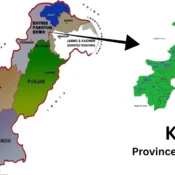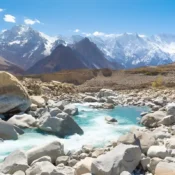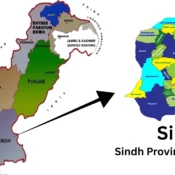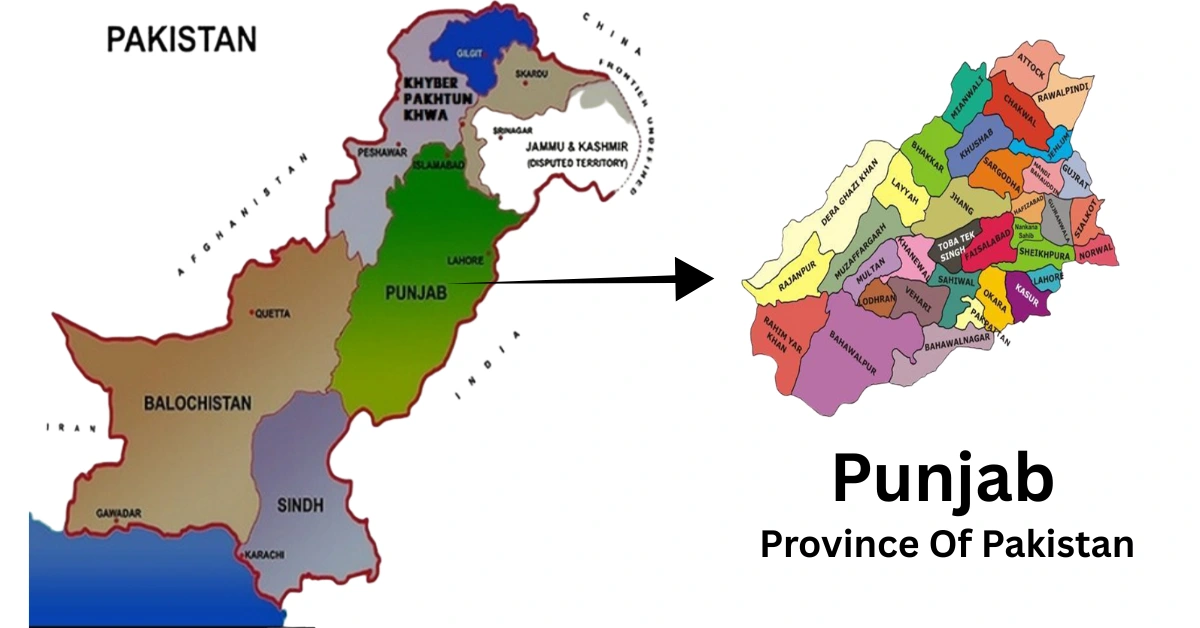
Discover Punjab: The Heart of Pakistan
Quick Facts About Punjab, Pakistan
- Population: The estimated population of Punjab in 2025 is about 131 million.
- Capital: Lahore
- Major Rivers: Jhelum, Chenab, Ravi, Sutlej, Beas
- Languages: Punjabi, Urdu, Saraiki, English
- Literacy Rate: 66.25% as of 2025, the highest among Pakistan’s provinces (Dawn).
- GDP Share: Punjab contributes over 50% of Pakistan’s economy (Economy of Pakistan – Wikipedia).
Imagine a land where fertile plains stretch endlessly, where history whispers through ancient forts, and where vibrant traditions bring life to every street. This is Punjab, often called the “Heart of Pakistan,” and rightly so, it is the country’s most populous and culturally vibrant province, with a projected 131 million people in 2025. Known for its fertile land, warm hospitality, and deep-rooted traditions, Punjab plays a central role in Pakistan’s history, economy, and identity.
Its very name comes from the Persian word Punj (five) and Ab (water), the land of five rivers: Jhelum, Chenab, Ravi, Sutlej, and Beas. These mighty rivers carved out fertile plains that have sustained civilizations for thousands of years, earning Punjab its reputation as the “breadbasket of South Asia.” From the Mughal-era grandeur of Lahore to the golden sands of the Cholistan Desert, and from bustling bazaars to serene riversides, Punjab is a land of contrasts and charm.
Source: Pakistani Census
History & Heritage
Punjab’s story stretches back thousands of years, written into the soil and stones of its land. One of the earliest chapters belongs to the Indus Valley Civilization. Around 2500 BCE, the city of Harappa, near Sahiwal, thrived as one of the world’s first urban centers. Its carefully planned streets, advanced drainage systems, and thriving trade networks reveal a society that was both organized and innovative, a foundation that shaped South Asia’s cultural heritage.
Centuries later, Punjab entered its golden age under the Mughals, who transformed Lahore into their cultural capital. The Badshahi Mosque, Lahore Fort, and Shalimar Gardens still stand as magnificent reminders of their artistry and vision. A walk through the Walled City of Lahore today feels like stepping back into that era of grandeur
In the 18th and 19th centuries, Punjab rose again under the Sikh Empire, led by Maharaja Ranjit Singh. Lahore regained its stature as a political and cultural center. For Sikhs around the world, sacred sites such as Nankana Sahib (birthplace of Guru Nanak) and the modern Kartarpur Corridor remain vital places of pilgrimage and connection.
The arrival of the British Raj marked yet another transformation. Colonial rulers left behind railways, administrative institutions, and centers of learning, such as Government College University and the Lahore Museum, transforming Lahore into an educational and political hub for the subcontinent .
Finally, in 1947, Punjab became the heart of Partition. It was here that borders were drawn, and with them came mass migrations, loss, and untold suffering. But out of this tragedy emerged resilience. Families rebuilt their lives, communities stood together, and Punjab carried forward its legacy of endurance and strength.
Fact: During Partition, nearly 14 million people migrated across Punjab’s new borders, the largest mass migration in recorded history.
Punjab is just one part of Pakistan’s incredible story. Explore the bigger picture on The Nature Beauty.
The Geography of Punjab
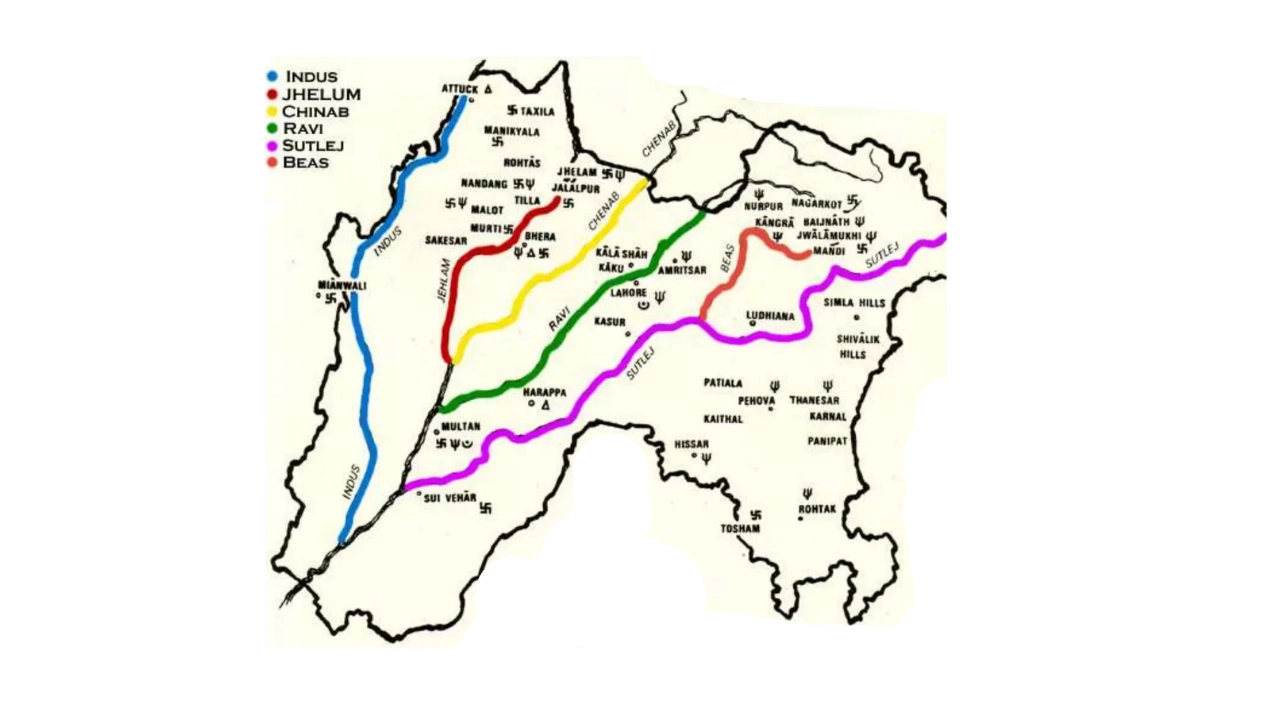
A breathtaking view of Punjab’s vast plains, where golden fields of wheat and rice stretch endlessly, intersected by winding canals, with the Salt Range rising in the north and the
Cholistan Desert shimmering in the south. At its heart, mighty rivers nourish the land, while bustling cities preserve centuries of history.
Punjab is the most populous province of Pakistan and a land where geography and culture meet prosperity. Covering 205,344 km² and home to nearly 131 million people (2025 est.), Punjab is the agricultural backbone of the country and the cultural heartbeat of Pakistan.
Source: Statista
-
Borders – Where Punjab Meets the World
Punjab holds a unique geographic position, connecting Pakistan internally and externally. To the north, it meets Khyber Pakhtunkhwa and Islamabad Capital Territory, while to the west it connects with Balochistan. The south merges with Sindh, and the northeast joins Azad Jammu and Kashmir.
Most importantly, Punjab shares its international border with India, stretching across its eastern side. The two main crossing points are Wagah (near Lahore), world-famous for its daily flag-lowering ceremony, and Ganda Singh Wala (near Kasur), historically significant for trade and cultural exchange. These borders symbolize both division and deep cultural ties between the two Punjabs.
Source: Wikipedia
-
Plains – The Breadbasket of Pakistan
Punjab’s plains are among the most fertile on earth, nourished by rivers and canals that form one of the world’s largest irrigation systems. These lands produce wheat, rice, sugarcane, and cotton in abundance, sustaining not only the province but much of the country. Punjab’s role as the breadbasket of South Asia continues to shape its economy and identity.
-
Hills and Plateaus – Guardians of the Horizon
In northern Punjab lies the Salt Range, a chain of rugged hills renowned for its rich mineral deposits, especially the Khewra Salt Mine, the second largest in the world. The Potohar Plateau adds rolling landscapes, gorges, and a history stretching back to the Gandhara civilization, while the Murree Hills, on the province’s edge, serve as a popular tourist destination for their cool climate and forested scenery.
-
Deserts – Oceans of Sand and Silence
Punjab’s southern lands are marked by the Cholistan Desert, where golden sand dunes stretch endlessly under the blazing sun. Known as the “Land of Silence,” it is famous for camel caravans, colorful desert festivals, and the iconic Derawar Fort. The Thal Desert, lying between the Indus and Jhelum rivers, adds another layer of geographical variety, supporting hardy crops and livestock in its semi-arid climate.
-
Rivers – Lifelines of the Land
The name Punjab itself means Land of Five Rivers, and these rivers are the lifeline of the province, shaping its agriculture, culture, and settlement.
- Jhelum River: Rising from the Indian-administered Kashmir, it is home to the Mangla Dam, a major source of electricity and irrigation.
- Chenab River: Flowing through central Punjab, it nourishes vast fields of rice and sugarcane and is immortalized in Punjabi folklore like Heer–Ranjha.
- Ravi River: Passing by Lahore, it adds beauty to the cultural capital and has historically been the site of Mughal gardens and settlements.
- Sutlej River: The longest of Punjab’s rivers, it sustains agriculture in southern districts, including Bahawalpur.
- Beas River: Though most of its flow now lies in India, it remains one of the original five rivers that gave Punjab its name and legacy.
-
Urban Landscapes
Punjab is also defined by its vibrant cities. Lahore, the provincial capital, stands as Pakistan’s cultural and artistic hub, blending Mughal architecture with modern urban life. Faisalabad is the industrial heart, often called the “Manchester of Pakistan” for its textile mills. Rawalpindi serves as an important military and trade center, while Multan, the “City of Saints,” is celebrated for its Sufi shrines and world-famous mangoes.
Quick Fact: Punjab may be Pakistan’s second-largest province by area, but it is the largest by population and economic contribution, producing more than 60% of the nation’s food supply and serving as the beating heart of the country’s agriculture and culture.
Punjab’s Growing Tourism Scene
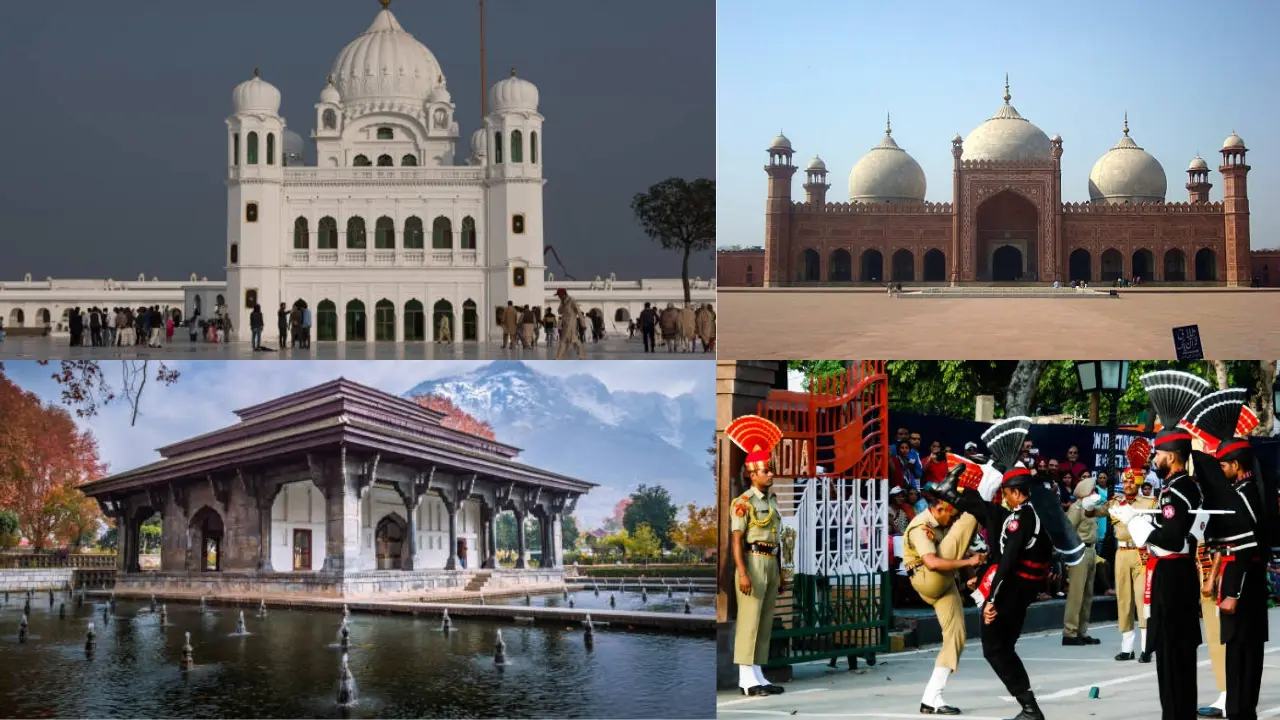
Punjab, often called the Heart of Pakistan, is quickly becoming a major destination for heritage, cultural, and religious tourism. With its historic cities, Mughal architecture, spiritual sites, and vibrant festivals, Punjab attracts millions of domestic and international visitors each year. In 2024, tourism in the province grew, especially through heritage, religious, and cultural attractions.
1. Heritage & Religious Tourism
Punjab is a key center for Pakistan’s heritage and religious tourism. Its Mughal landmarks, Sikh pilgrimage sites, and cultural attractions make it a popular destination year-round.
International Visitors (2024): 200,000 – 300,000
Domestic Visitors (2024): 10 – 15 million
Source: Statista
-
Key Attractions:
- Lahore Fort & Shalimar Gardens
- Badshahi Mosque & Wazir Khan Mosque
- Sikh pilgrimage sites: Kartarpur Corridor, Nankana Sahib, and Panja Sahib
- Wagah Border Ceremony
- Multan: The “City of Saints” with its Sufi shrines
Heritage and religious tourism is growing, with more Sikh pilgrims visiting the Kartarpur Corridor and increasing international cultural tourism in Lahore.
2. Cultural & Festival Tourism
Punjab is known for its lively festivals, food, and arts, which draw tourists eager to experience its traditions.
-
Key Attractions:
- Basant Festival (Lahore): Celebrated with kite flying and music
- Urs Festivals in Multan & Pakpattan: Sufi gatherings attracting millions
- Lahore Literature Festival & Punjab Food Festivals: Celebrating art, history, and local food
These cultural experiences make Punjab a top choice for both domestic and international travelers looking for authentic South Asian traditions.
3. Eco & Agro-Tourism
Punjab’s countryside, deserts, and rivers are gaining popularity for eco-tourism and rural getaways.
-
Key Attractions:
- Cholistan Desert: Derawar Fort, Jeep Rally, and desert festivals
- Salt Range & Khewra Salt Mine: The second-largest salt mine in the world, with ancient temples and fossil-rich hills
- Canal-side Villages: Traditional Punjabi farming, mango orchards (Multan), and citrus groves (Sargodha)
Eco-tourism in Punjab blends farming with cultural hospitality, offering a unique experience compared to northern adventure tourism.
4. Urban & Modern Tourism
Punjab’s cities combine history with modern life, offering tourists a mix of cultural heritage and contemporary lifestyles.
-
Key Cities:
- Lahore: Pakistan’s cultural capital, with Mughal monuments, vibrant bazaars, food streets, and modern malls
- Faisalabad: Known as the “Manchester of Pakistan” for its textile industry and clock tower bazaars
- Rawalpindi & Islamabad: Twin cities that serve as gateways to northern areas, with historical markets and modern city life
- Multan: A blend of Sufi heritage and busy handicraft markets
Quick Fact: Punjab’s tourism is driven by heritage, religious pilgrimages, and vibrant cultural experiences, with Lahore alone welcoming hundreds of thousands of international visitors each year. It stands as Pakistan’s leading destination for cultural and religious tourism, complementing the adventure-focused northern regions.
People & Culture
If there’s one thing Punjabis are famous for, it’s their warmth. Step into a Punjabi home and you’ll rarely leave without a meal, a story, and plenty of laughter. Hospitality here isn’t a custom — it’s a way of life.
-
Languages:
Punjabi fills the streets and songs of daily life, Saraiki adds its melody in the south, while Urdu and English dominate classrooms, offices, and media.
-
Faiths:
Punjab is predominantly Muslim but also home to vibrant Christian, Hindu, and Sikh communities, each contributing to the province’s diverse cultural fabric.
-
Traditions:
The beat of the dhol drives folk dances like Bhangra and Luddi, while the mystical notes of qawwali echo from Sufi shrines.
-
Crafts:
From colorful phulkari embroidery to Multani blue pottery and finely woven carpets, Punjab’s artisans continue centuries-old traditions.
-
Sports:
Whether it’s a dusty kabaddi field in a village or a packed cricket stadium in Lahore, Punjabis play and cheer, with unmatched passion.
Fact: The Punjabi language is spoken by over 125 million people worldwide, making it one of the top 10 most spoken languages on the planet.
Food – Flavors of Pakistan
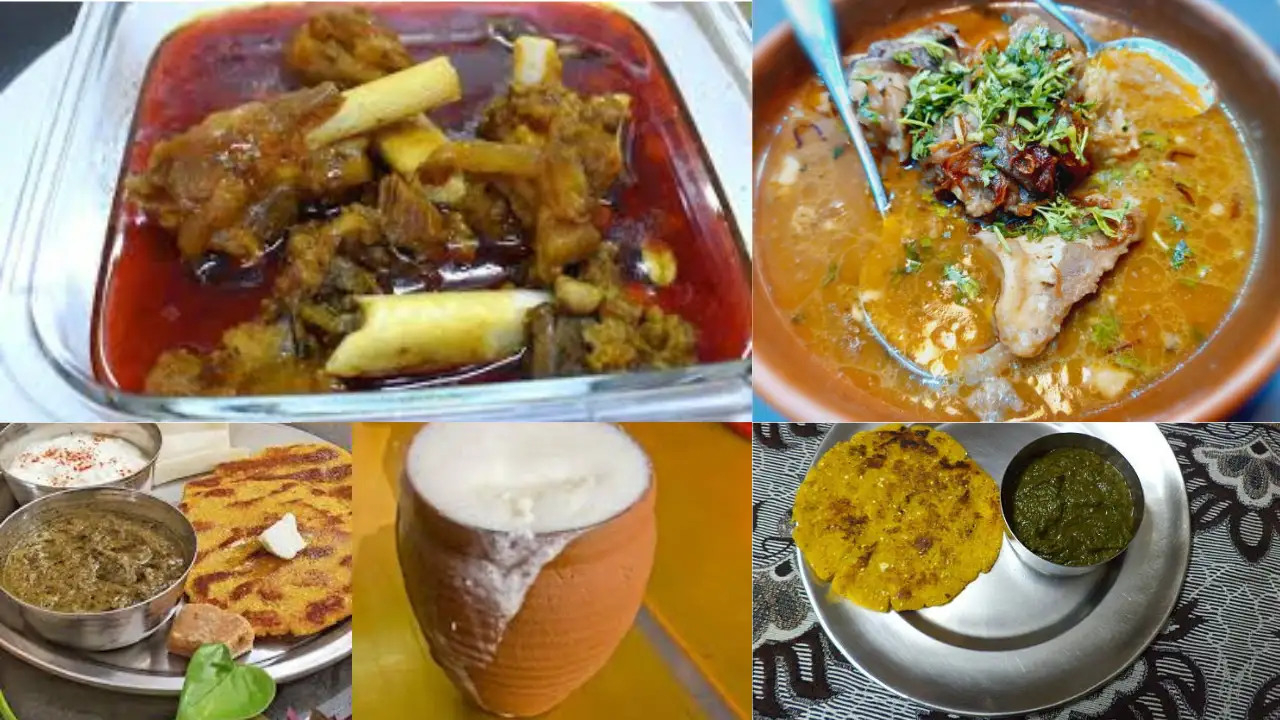
In Punjab, food isn’t just about eating — it’s about sharing, celebrating, and savoring life. Meals are bold, hearty, and served with the kind of generosity that makes guests feel like family.
-
Everyday staples:
Fresh roti pulled hot from a clay tandoor, paired with lentils or seasonal vegetables, form the base of most meals.
-
Signature dishes:
Few things define Punjab better than sarson da saag with makki di roti in winter. Add to that the rich flavors of Nihari, Haleem, Siri Paye, and the ever-popular Lahori Karahi.
-
Street foods:
From crispy golgappay and spicy chaat to sizzling bun kebabs and crunchy samosas, Punjab’s streets are alive with flavor.
-
Sweets:
No celebration is complete without jalebi, gulab jamun, barfi, or a warm bowl of gajar ka halwa.
-
Drinks:
And of course, no Punjabi meal feels complete without a tall, frothy glass of lassi — creamy, refreshing, and perfect in every season.
Fact: Punjab is one of the world’s largest mango producers, and its varieties — like Chaunsa and Anwar Ratol — are exported and adored across the globe.
Festivals & Celebrations
In Punjab, life is measured in festivals as much as in seasons. Every few weeks, there’s a reason to gather, sing, feast, and celebrate, whether in a village courtyard or a bustling city street.
-
Eid al-Fitr & Eid al-Adha:
Marked with prayers, family reunions, feasts, and acts of charity, these are the heartbeats of the Muslim calendar.
-
Basant:
Once, the skies of Lahore glowed yellow and red as thousands of kites soared, turning rooftops into playgrounds of joy.
-
Baisakhi & Lohri:
Harvest festivals filled with dhol beats, bhangra dances, and communal feasting, reminding everyone of Punjab’s deep bond with the land.
-
Urs at Sufi shrines:
Pilgrims gather around the shrines of saints, where qawwali music, poetry, and free community meals keep centuries-old spiritual traditions alive.
Fact: Lahore’s Basant festival was once so famous that people traveled from all over the world to witness its kite-flying spectacle, a tradition now remembered as one of the city’s most iconic cultural symbols.
Cities – The Living Pulse of Pakistan
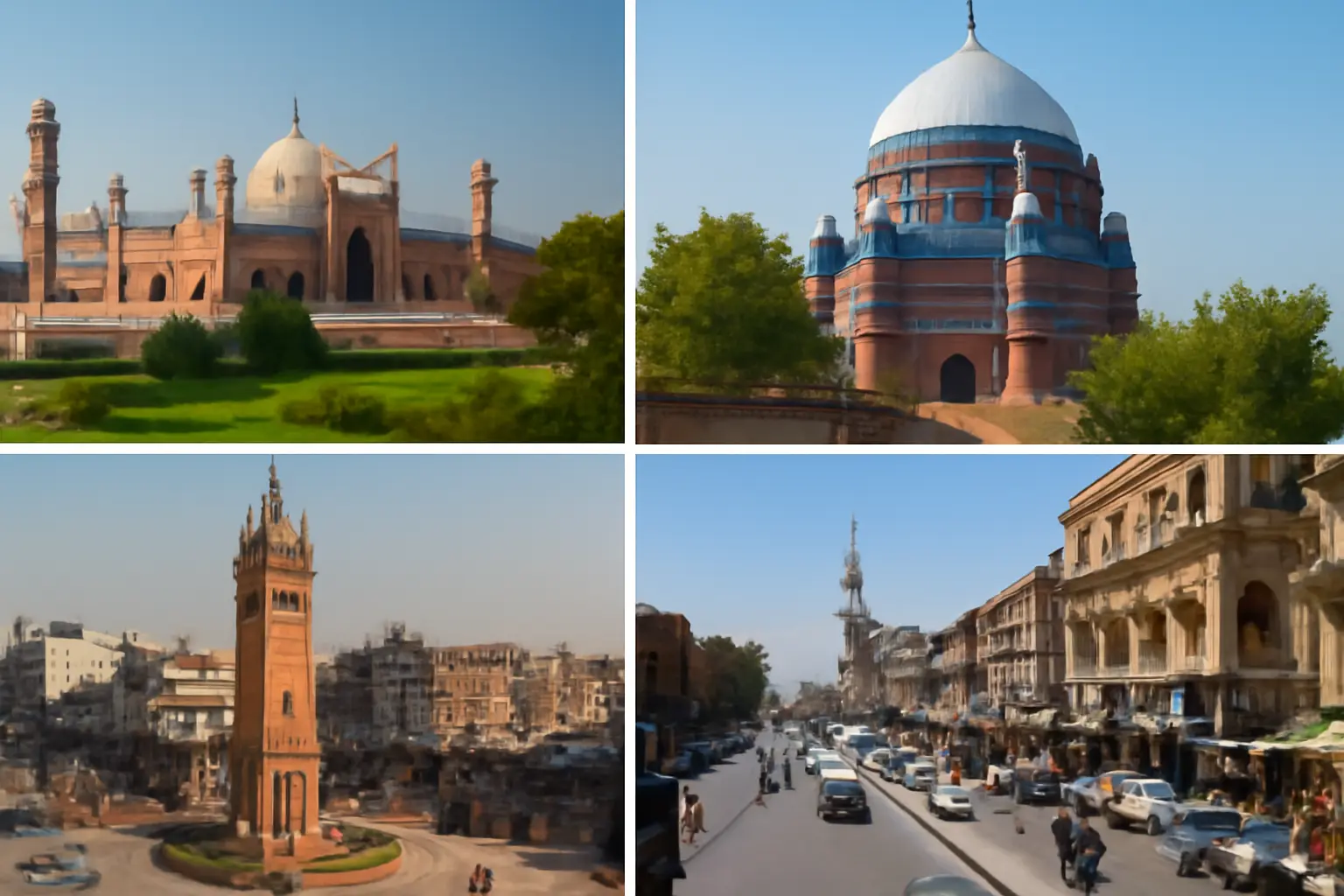
Punjab’s cities are as diverse as its landscapes — each carrying its own story, flavor, and heartbeat.
-
Lahore:
The cultural capital of Pakistan, where Mughal-era landmarks like the Badshahi Mosque and Lahore Fort stand beside buzzing food streets and vibrant art scenes. From the winding alleys of the Walled City to modern boulevards, Lahore blends tradition and progress effortlessly.
Population: 13.5 Miliion Projected For 2025 using 2017-2023 annual growth rate of 2.63%
Traveler’s Tip: Don’t miss Lahore’s Food Street at night — it’s where history and flavor meet.
-
Multan:
Known as the “City of Saints,” Multan glows with the domes of Sufi shrines, lively bazaars, and the sweetness of its world-renowned mangoes. Its famous blue pottery and handicrafts keep age-old artistry alive.
Population: 2.3Million Projected for 2025 using 2017-2023 annual growth rate of 2.85%
Fact: Multan is home to over 1,000 shrines, making it one of the most spiritually significant cities in South Asia.
-
Faisalabad:
Often called the “Manchester of Pakistan,” Faisalabad is the powerhouse of Pakistan’s textile industry. The eight bazaars around Ghanta Ghar (Clock Tower) are designed like the Union Jack, a unique urban layout inherited from the British era.
Population: 3.8 Million Projected for 2025 using 2017-2023 annual growth rate of 2.39%.
-
Rawalpindi:
Twin city to Islamabad, Rawalpindi blends colonial charm with urban bustle. Its Raja Bazaar, historic buildings, and role as a military hub make it both busy and fascinating.
Population: 3.9 Million Projected for 2025 using 2017-2023 annual growth rate of 8.15%
Traveler’s Tip: Pair a Rawalpindi visit with Islamabad for a perfect mix of heritage and modernity.
-
Bahawalpur:
A city of palaces and deserts. The Noor Mahal and Derawar Fort showcase royal grandeur, while Bahawalpur also serves as the gateway to the Cholistan Desert and its famous jeep rallies.
Population: 957 Thousand Projected for 2025 using 2017-2023 annual growth rate of 2.88%.
-
Sialkot:
A global hub of craftsmanship, Sialkot is where the world’s finest sports goods are made — including footballs used in FIFA tournaments. It’s a city of innovation, pride, and global reputation.
Population: 1 Million Projected for 2025 using 2017-2023 annual growth rate of 5.65%
Fact: Over 70% of the world’s hand-stitched footballs are made in Sialkot.
-
Sargodha:
The “City of Oranges,” where citrus orchards perfume the air and fields turn golden in harvest season. Sargodha is also strategically important due to its airbase.
Population: 1.1Million Projected for 2025 using 2017-2023 annual growth rate of 6.78%. -
Jhelum:
A historic garrison town with links to Alexander the Great’s battle at the Hydaspes River. Close by, visitors can explore Rohtas Fort and the shimmering Khewra Salt Mines.
Population: 368 Thousand Projected for 2025 using 2017-2023 annual growth rate of 8.6%.
Punjab’s story doesn’t end here. Beyond these major urban centers, countless other cities pulse with life and character — Gujranwala with its famous wrestlers and cuisine, Sheikhupura with its Mughal-era Hiran Minar, Okara with fertile farmlands, Kasur known for the poetry of Bulleh Shah, and Gujrat celebrated for its furniture and ceramics. Each city, big or small, adds a unique thread to Punjab’s vast cultural and economic fabric, making the province a true mosaic of history, tradition, and progress.
Punjab is just one part of Pakistan’s incredible story. Explore the bigger picture on The Nature Beauty.
Economy – From Fields to Factories
Punjab is Pakistan’s economic engine, contributing more than half of the national GDP). In FY2024–25, Pakistan recorded 2.68% GDP growth, supported largely by Punjab’s output . For FY2025–26, the provincial budget is Rs5.33 trillion ($18.9 billion), with 47% allocated to development projects.
Sources: Brecorder, Finance Punjab, Wikipedia
1. Agriculture
- Contributes 25% of Punjab’s GDP.
- Accounts for 69% of Pakistan’s cropped area.
- Wheat alone covers 40% of Punjab’s cultivated land.
- Average wheat production: 27.7 million tons annually.
- Major crops: wheat, rice, sugarcane, cotton, mangoes, and citrus.
- Source: USDA
2. Industry
- Contributes 30% of Punjab’s GDP, including manufacturing.
- Punjab has over 48,000 industrial units .
- Faisalabad: textile industry hub.
- Sialkot: sports goods industry; exports $178 million annually, employing 200,000+ workers
- Gujranwala: ceramics and light engineering.
3. Services & IT
- Rapid growth in IT and services sector.
- Lahore is the leading provincial hub for IT, startups, and freelancing.
- Punjab contributes to Pakistan’s $4B+ IT exports
At a Glance
| Sector | Contribution to Punjab Economy | Key Stats (Latest) |
| Agriculture | ~25% of provincial GDP | 69% of Pakistan’s cropped area; wheat yield 3.03 tons/ha (5-year avg) (USDA) |
| Industry | ~30% (incl. manufacturing) | Over 48,000 industrial units; Sialkot sports goods employ 200,000+ (DHL) |
| Services/IT | Growing rapidly | Lahore IT exports rising; part of national $4B+ IT sector (Economy of Pakistan – Wikipedia) |
Education – The Pathway to Progress
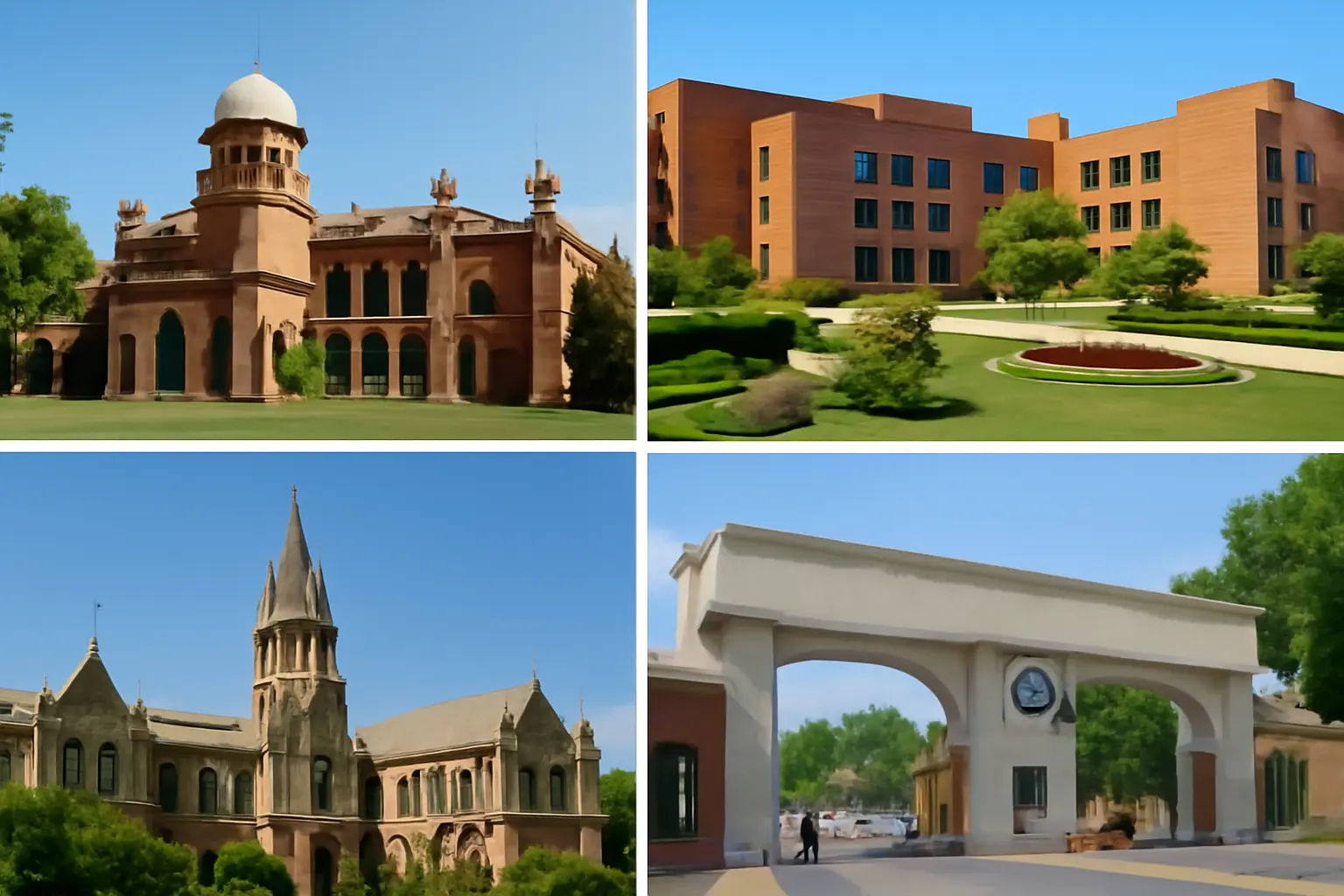
Punjab leads the nation in education, with a literacy rate of 66.25% (2024–25 Economic Survey), the highest among Pakistan’s provinces . In 2025, the World Bank launched an education project expected to benefit over 4 million children across the province (World Bank Press Release).
Key Universities in Punjab & Rankings
-
University of the Punjab (est. 1882, Lahore)
One of the oldest and largest universities in South Asia. In QS Asia University Rankings 2025, it ranked among the top 250 universities in Asia.
-
LUMS – Lahore University of Management Sciences (Lahore)
Widely regarded as Pakistan’s leading private university, LUMS was placed in the Top 200 Asian universities in the QS World University Rankings 2025, recognized especially for its business and economics programs.
-
King Edward Medical University (KEMU) (est. 1860, Lahore)
Pakistan’s oldest medical school, consistently ranked among the top medical universities in South Asia for its research and clinical training.
-
UET Lahore – University of Engineering & Technology (Lahore)
Known for engineering and technology, UET ranked in the Top 300 Asian universities in the QS Asia Rankings 2025, excelling in Civil and Electrical Engineering.
-
GCU Lahore – Government College University (Lahore)
A historic institution with alumni like Allama Iqbal. In 2025, GCU appeared in the Times Higher Education Impact Rankings for its contributions to Sustainable Development Goals (SDGs).
-
University of Agriculture (Faisalabad)
Ranked among the top agricultural universities in Asia, UAF is globally recognized for its research in food security, crop sciences, and sustainable agriculture.
-
Bahauddin Zakariya University (Multan)
A major public university serving southern Punjab. It offers diverse programs and is especially noted for agriculture, veterinary sciences, and engineering.
Not only these, Punjab is home to many more universities and colleges that play a vital role in advancing education, research, and innovation. Together, they make the province a true center of learning and opportunity in Pakistan.
Arts, Handicrafts & Entertainment
Punjab’s artistry is more than craft, it’s memory stitched, carved, and painted into everyday life. The delicate phulkari embroidery, with its vibrant floral patterns, has traveled from village looms to international fashion ramps. The blue pottery of Multan, with its signature cobalt shades, continues to enchant collectors, while hand-carved wooden furniture from Chiniot still decorates homes across the Middle East and beyond. Each craft is not just a product but a story of generations passing down skills, of traditions surviving change, and of pride woven into every detail.
Entertainment thrives just as brightly. Lahore, the beating cultural heart of Pakistan, is where creativity finds its stage. The city’s old theatres and modern art galleries stand side by side, celebrating both tradition and innovation. It was here that Lollywood, Pakistan’s film industry, was born — producing classics that defined an era. Today, the city still buzzes with film festivals, music concerts, and theatre productions, proving that Punjab’s spirit of storytelling is as alive as ever. From soulful qawwalis at shrines to experimental theatre in downtown Lahore, Punjab’s entertainment scene continues to reinvent itself while honoring its deep artistic roots.
Fact: Multani blue pottery, famous for its cobalt blue and white designs, dates back over 700 years and was introduced to South Asia during the Mughal era, blending Persian, Central Asian, and local artistic traditions.
Sports & Passion
Sport in Punjab is not just recreation, it’s heartbeat, heritage, and pride. In the villages, dusty kabaddi grounds come alive with roaring crowds, and wrestling matches under open skies turn into community festivals. These traditional games aren’t played for trophies alone; they honor endurance, loyalty, and cultural identity, keeping centuries-old traditions alive in every grapple and every cheer.
Modern sports carry that same fire. Punjab is the epicenter of Pakistan’s cricket and hockey, with stadiums in Lahore and beyond shaking with chants whenever the green shirts take the field. The province also leads in inclusive sporting events, most notably the Pink Games 2025, Pakistan’s flagship women’s sports festival, which brought together over 3,000 female athletes from across the country (ProPakistani).
But Punjab’s influence doesn’t stop at home. The city of Sialkot has become a global hub, producing over 70% of the world’s hand-stitched footballs, including those used in FIFA World Cups. With more than 200,000 workers powering this industry, Punjab’s craftsmanship doesn’t just fuel matches, it fuels dreams worldwide. Exports valued at $282 million (2024) continue to grow.
Quick Fact: Sialkot produced the official match ball for the FIFA World Cup, making Punjab’s handiwork central to the world’s biggest sporting event.
Punjab’s story is Pakistan’s story. To continue exploring the country’s beauty, history, and culture, head towards Welcome to Pakistan.
Places to Visit
Punjab is a traveler’s canvas — where every fort, shrine, and street has a story to tell. From Mughal grandeur to ancient ruins, from desert palaces to snowy hilltops, the province offers experiences as diverse as its landscape.
-
Walled City of Lahore
A living museum of havelis, bazaars, and food streets, the Walled City feels like stepping back into the Mughal era. Restored gems like the Shahi Hammam and Delhi Gate breathe life into centuries-old history.
Fact: The Walled City of Lahore once had 13 gates, each with unique significance, today, only 6 remain intact.
-
Harappa Ruins (Sahiwal)
Once part of the Indus Valley Civilization (c. 2500 BCE), Harappa reveals advanced urban planning, pottery, and artifacts. For history lovers, it’s a chance to walk through one of humanity’s earliest cities.
Fact: Harappa’s drainage system was so advanced that archaeologists compare it to modern urban planning. -
Rohtas Fort (Jhelum)
Built by Sher Shah Suri in the 16th century, this World Heritage Site is famed for its massive stone walls that once defended the Grand Trunk Road. It’s a masterpiece of military architecture.
Fact: The fort covers 70 hectares and has 12 gates, making it one of the largest forts in South Asia.
-
Khewra Salt Mines (Jhelum)
Among the world’s oldest and largest salt mines, Khewra produces Pakistan’s iconic pink Himalayan salt. Visitors can explore underground mosques, illuminated salt chambers, and carved salt structures .
Fact: The Khewra Salt Mine produces about 387,000 tons of salt annually and is believed to be discovered by Alexander the Great’s army. -
Derawar Fort (Bahawalpur)
Rising dramatically from the Cholistan Desert, this 40-bastion fort dominates the sandy horizon. It also hosts the annual Cholistan Jeep Rally, blending history with adrenaline.
Fact: The walls of Derawar Fort are 30 meters high and stretch for almost 1,500 meters around the fort. -
Noor Mahal (Bahawalpur)
A fairytale-like palace, Noor Mahal combines Italian and subcontinental architecture. Its glowing white domes and chandeliers make it one of the most photographed landmarks in Punjab.
Fact: Noor Mahal was built in 1872 by Nawab Sadiq Muhammad Khan IV but was used for residence only once.
-
Shrines of Multan
Known as the City of Saints, Multan is home to spiritual landmarks like the shrines of Bahauddin Zakariya and Shah Rukn-e-Alam, where Sufi poetry, music, and devotion thrive.
Fact: Shah Rukn-e-Alam’s tomb is one of the finest examples of Tughlaq architecture, attracting over 100,000 pilgrims during annual urs festivals.
-
Hiran Minar (Sheikhupura)
A Mughal hunting retreat built by Emperor Jahangir, Hiran Minar is unique for its 40-foot-high tower built in memory of his pet deer, surrounded by a water tank, a peaceful blend of architecture and nature.
Fact: The central tank at Hiran Minar covers 750 feet on each side and has a pavilion in the center accessible by a causeway.
-
Murree & Hill Stations
Nestled in the Himalayan foothills, Murree has long been Pakistan’s favorite summer retreat. Pine forests, snow-capped winters, and bustling Mall Road make it a timeless getaway.
Fact: Murree was founded as a British colonial hill station in 1851, and its Mall Road still carries that colonial charm today.
Note: Tourism in Punjab supports Pakistan’s projected $4.26 billion travel market revenue in 2025, with rising interest from the Pakistani diaspora.
Incredible Facts About Punjab, Pakistan
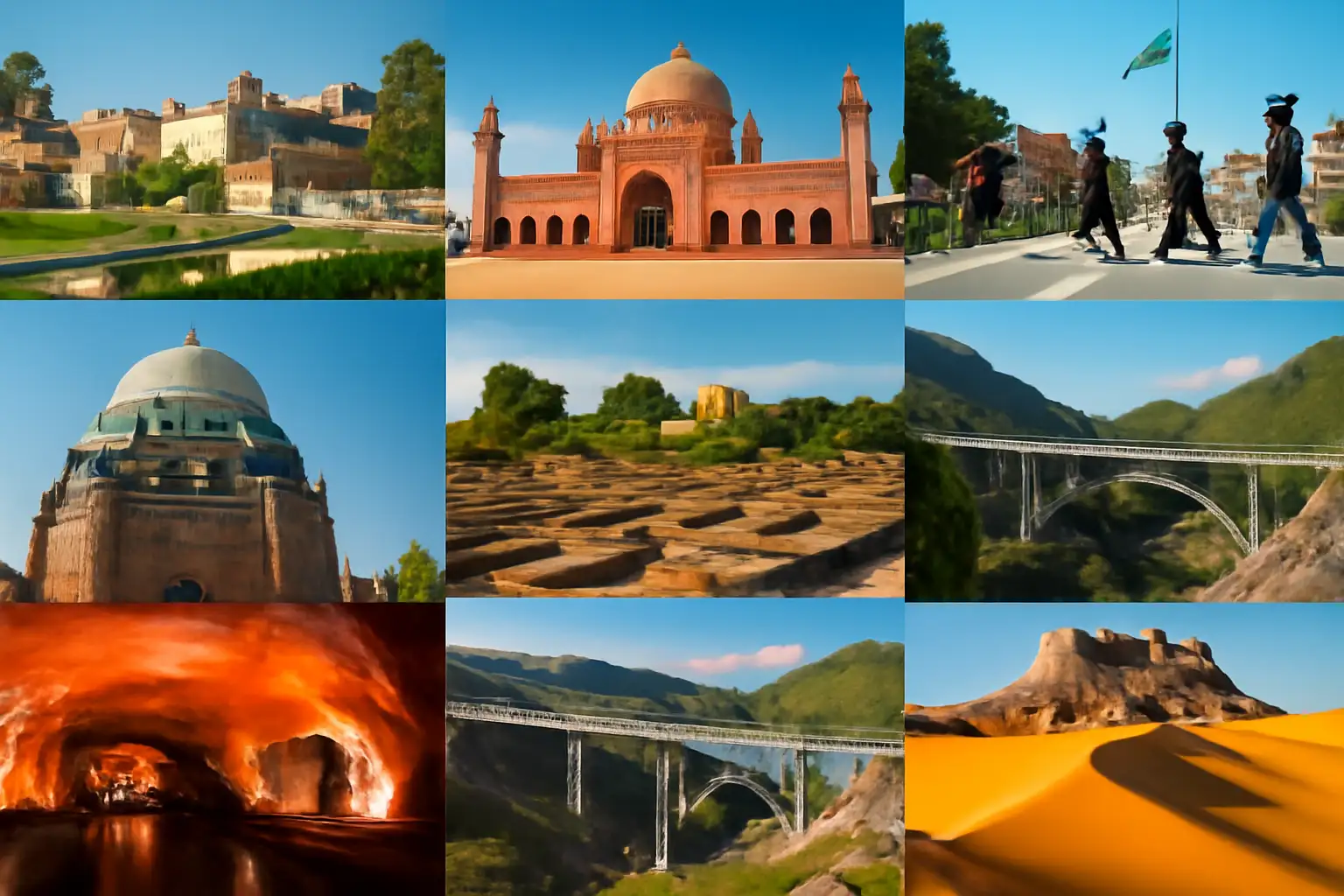
Punjab, often called the “Land of Five Rivers”, is the cultural and agricultural heart of Pakistan. Rich in history, natural beauty, and modern infrastructure, it holds a unique position in shaping the country’s heritage and economy. From Mughal-era marvels to fertile plains that feed the nation, Punjab offers a fascinating mix of tradition and progress.
1. Historical Sites
Punjab’s land has been home to ancient civilizations, Sufi saints, and Mughal emperors. Its historical sites reflect centuries of glory, faith, and resilience.
-
Lahore Fort & Shalimar Gardens – World Heritage Sites:
The Lahore Fort, dating back to the Mughal era, and the Shalimar Gardens (built in 1642 by Shah Jahan) are listed as UNESCO World Heritage Sites. They stand as symbols of Mughal architectural brilliance and cultural grandeur.
Fact: Murree was founded as a British colonial hill station in 1851, and its Mall Road still carries that colonial charm today. -
Badshahi Mosque – Mughal Majesty:
Built in 1673 by Emperor Aurangzeb, the Badshahi Mosque in Lahore remains one of the world’s largest mosques. Its vast courtyard and intricate design represent Punjab’s central role in Islamic history.
-
Multan – The City of Saints:
Multan is one of the oldest living cities in the subcontinent, known for its Sufi shrines, including Hazrat Bahauddin Zakariya and Shah Rukn-e-Alam. It is a hub of spirituality and tradition.
-
Harappa – The Indus Valley Civilization:
Located in Sahiwal District, Harappa was one of the main urban centers of the ancient Indus Valley Civilization. Archaeological remains showcase advanced urban planning dating back over 4,500 years.
2. Cultural Landmarks
Punjab is the cultural heartbeat of Pakistan, where hospitality, music, festivals, and traditions thrive.
-
Wagah Border Ceremony – Spirit of Patriotism:
Every evening, the Wagah Border hosts a flag-lowering ceremony between Pakistan and India. Thousands of spectators gather to witness this vibrant display of national pride.
-
Sikh Heritage – A Spiritual Connection:
Punjab is home to sacred Sikh sites, including Gurdwara Kartarpur Sahib and Gurdwara Panja Sahib, attracting thousands of pilgrims every year from around the world.
-
Festivals – Basant & Urs Celebrations:
From the colorful kite-flying festival Basant in Lahore (historically) to Urs festivals honoring Sufi saints in Multan, Punjab’s cultural calendar is full of life and tradition.
3. Infrastructure Marvels of Punjab
Punjab combines historical architecture with modern engineering that strengthens its economy and connectivity.
-
Khewra Salt Mine – The World-Famous Pink Salt:
Located in Jhelum District, Khewra Salt Mine is the second-largest salt mine in the world. It produces the renowned Himalayan pink salt, exported globally.
-
Fort Munro Steel Bridge – Engineering Wonder:
Built across the Sulaiman Mountain Range in South Punjab, the Fort Munro Steel Bridge is considered the second-largest steel bridge in Asia, improving connectivity to remote areas.
-
Motorways Network – Modern Connectivity:
Punjab has the densest motorway and highway system in Pakistan, including M-1, M-2, and M-3, linking major cities like Lahore, Islamabad, Faisalabad, and Multan.
4. Natural Features
Though known for its plains, Punjab also boasts diverse landscapes and resources.
-
Salt Range – Geological Treasure:
Stretching across districts like Chakwal and Jhelum, the Salt Range is rich in minerals, fossils, and wildlife, making it both a natural wonder and economic asset.
-
Cholistan Desert – Cultural Wilderness:
Located near Bahawalpur, Cholistan is famous for the Derawar Fort and the annual Cholistan Jeep Rally, blending desert culture with adventure tourism.
5. Land Of Five Rivers
Punjab, meaning “land of five rivers”, is named after the rivers that sustain its agriculture and civilization.
- Jhelum River:
- Chenab River:
- Ravi River:
- Sutlej River:
- Beas River:
These rivers collectively feed the Indus Basin Irrigation System, the largest contiguous irrigation network in the world.
Punjab’s story is Pakistan’s story. To continue exploring the country’s beauty, history, and culture, head towards Welcome to Pakistan.
Conclusion
Punjab is more than just a province, it is the heartbeat of Pakistan. From the fertile plains that feed millions to the ancient ruins that whisper stories of lost civilizations, Punjab stands as a land where history, culture, and progress converge. Its bustling cities hum with industry and art, while its villages preserve traditions that span centuries. Festivals, food, music, and hospitality make life here a celebration, while its universities and industries keep it firmly connected to the future.
As the “Land of Five Rivers,” Punjab continues to nourish not only the soil but also the spirit of the nation. Whether you come seeking history in Lahore’s Walled City, adventure in the Cholistan Desert, or the simple joy of a glass of lassi under the summer sun, Punjab offers an experience that stays with you long after you leave. It is a place of resilience and warmth, a mosaic of stories past and present — truly, the Heart of Pakistan.
Come, feel the spirit of Punjab for yourself.
✨ To truly understand Pakistan is to journey through its lands, people, and stories. Explore more of what makes this country extraordinary:
-
Discover the full story of Pakistan: Discovering Pakistan
- Khyber Pakhtunkhwa – Gateway To Mountains & Culture → KPK
-
Wander the landscapes and spirit of Sindh: Explore Sindh
-
Seek out adventure in every corner with Adventure in Pakistan
Let every blog guide you to new horizons—lands to explore, stories to live, and beauty to share.
Frequently Asked Questions
Q1: What is life like in Pakistani Punjab compared to other provinces in terms of food, culture, and daily living?
Ans: Life in Punjab feels vibrant and full of energy. Compared to the rugged mountains of Khyber Pakhtunkhwa or the deserts of Sindh and Balochistan, Punjab is greener, busier, and more urbanized. Food is rich and hearty, culture is colorful and festive, and daily living revolves around hospitality, family ties, and agriculture.
Q2: Are people in Pakistani Punjab religious, traditional, or more modernized?
Ans: Punjabis carry a mix of all three. Faith plays a big role in everyday life, traditions like weddings and festivals remain deeply rooted, yet big cities like Lahore and Faisalabad are also modern hubs with cafes, malls, startups, and universities. It’s a blend of mosque calls at dawn, village fairs, and tech-savvy youth on Instagram.
Q3: What are some amazing facts about Pakistani Punjab?
-
Punjab produces more than 60% of Pakistan’s food.
-
Sialkot makes over 70% of the world’s hand-stitched footballs.
-
Harappa, one of the world’s oldest cities (2500 BCE), is located here.
-
Lahore’s Badshahi Mosque was once the largest mosque in the world.
-
Multan is home to over 1,000 shrines, earning it the title “City of Saints.”
Q4: Is Punjab located in both India and Pakistan, or just one country?
Ans: Yes, Punjab is divided between India and Pakistan. After Partition in 1947, the eastern part became Indian Punjab, while the western part became Pakistani Punjab. Today, both sides share the same cultural roots, language, and traditions, even though they are in different countries.
Q5: Do most people in Pakistani Punjab speak Punjabi, and when do they use it?
Ans: Yes — Punjabi is the mother tongue for most people in the province. It’s the language of homes, songs, and everyday conversations. However, Urdu is often used in schools, offices, and media, while English dominates in higher education and business circles.
Q6: What are the key historical sites in Pakistani Punjab?
Ans: Some must-see landmarks include:
-
Lahore Fort & Shalimar Gardens (UNESCO sites)
-
Badshahi Mosque – Mughal grandeur
-
Harappa – ancient Indus Valley city
-
Rohtas Fort (UNESCO) – Sher Shah Suri’s masterpiece
-
Shrines of Multan – centuries of Sufi tradition
-
Derawar Fort – desert stronghold in Cholistan
Q7: How does Punjab contribute to Pakistan’s economy?
Ans: Punjab is Pakistan’s economic powerhouse, contributing more than half of the national GDP. It leads in agriculture (wheat, rice, mangoes, citrus), industry (textiles in Faisalabad, sports goods in Sialkot), and services (IT startups in Lahore). In short: if Pakistan is the body, Punjab is its beating heart.
Q8: What are popular tourist attractions in Punjab, Pakistan?
Ans: Tourists flock to:
-
The Walled City of Lahore for food and heritage
-
Khewra Salt Mines for glowing underground chambers
-
Cholistan Desert for the jeep rally and Derawar Fort
-
Multan’s shrines and bazaars
-
Murree and hill stations for cool escapes
-
Kartarpur Corridor & Nankana Sahib for Sikh pilgrims
Q9: How does the Punjabi language fare in Pakistan today?
Ans: Punjabi is alive and well as a spoken language — it’s everywhere in songs, theatre, and daily conversations. But it faces challenges in schools and official settings, where Urdu and English dominate. Many cultural movements and poets are working hard to keep Punjabi literature and script alive.
Q10: What are the main festivals celebrated in Pakistani Punjab?
Ans: Punjab celebrates both religious and cultural festivals, including:
-
Eid al-Fitr & Eid al-Adha – with prayers, food, and family gatherings
-
Urs festivals at Sufi shrines with qawwali and poetry
-
Basant (kite festival) in Lahore (historically)
-
Baisakhi & Lohri – harvest celebrations
-
Mela Chiraghan – Festival of Lights at Shah Hussain’s shrine
Q11: Is there a difference between Lahore Punjabi and standard Punjabi?
Ans: Yes — Lahore Punjabi is considered the “standard” or urban Punjabi, smoother and often mixed with Urdu. In southern Punjab, Saraiki is widely spoken, while in rural areas, Punjabi can sound more rustic and traditional. Each region has its own flavor, but Lahori Punjabi often sets the trend in media and pop culture.
Q12: What role does Punjab play in Pakistan’s education and sports?
Ans: Punjab leads in both. Lahore alone houses top universities like LUMS, Punjab University, and KEMU, making the province an education hub. In sports, Punjab dominates cricket, hockey, kabaddi, and wrestling. And globally, Punjab’s Sialkot is the factory of the world’s footballs, even supplying FIFA World Cups.

